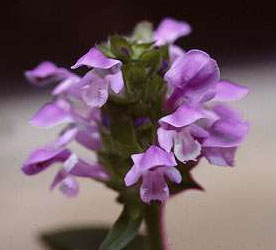
 This plant is at home all over the country and grows with great vigor in the South. It is an Eurasian import, long naturalized, and can be found growing in low woods and thickets in partial shade, in yards, lake margins, fields, waste places, pastures and roadsides.
This plant is at home all over the country and grows with great vigor in the South. It is an Eurasian import, long naturalized, and can be found growing in low woods and thickets in partial shade, in yards, lake margins, fields, waste places, pastures and roadsides.It is a common weed, a low perennial with a short rhizome, reproducing by seeds and short runners that root freely at the nodes. As with other members of the mint family, the stems are square and the leaves are opposite. The stems branch freely and are usually about one foot tall; but when repeatedly mowed, the plants become densely matted, depressed and small-leaved.
The lower leaves are petioled, with the blades lanceolate to ovate. The upper leaves are sessile, subtending the flower cluster. The flower cluster is a close thick spike with three flowers in the axils of each rounded bract.
The flowers are two-lipped, the upper lip hood-shaped, the lower lip shorter and three-lobed. The blossoms are lavender to white and their nectar attracts honeybees, bumblebees and some kinds of butterflies. Blooming time is March to frost.
Originally, Prunella was called Brunella, from the German bruen meaning quinsy, a disorder of the throat, for which this plant was considered a certain cure. Vulgaris comes from vulgus, meaning of the common people. Both refer to the ancient belief in the healing powers of this plant.
It has been used medicinally to cure many ailments. No wonder it is called Heal-all. We find it used for the treatment of boils, gas, colic, sore throat, hemorrhages, and diarrhea. It is much esteemed for healing wounds as it is an effective astringent, thus useful in stopping the flow of blood from a cut or wound.
